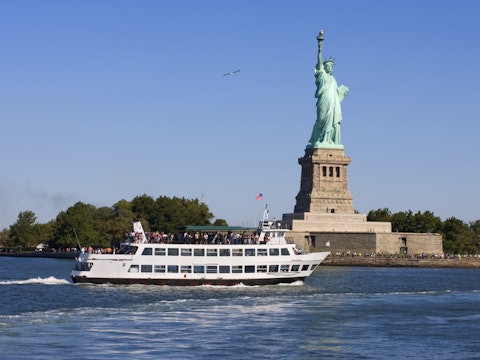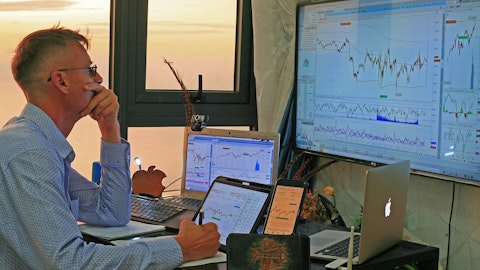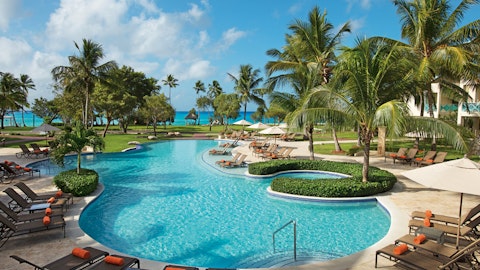Carnival Corporation & plc (NYSE:CCL) Q1 2023 Earnings Call Transcript March 27, 2023
Josh Weinstein: Good morning. This is Josh Weinstein. Welcome to our First Quarter 2023 Business Update Conference Call. I’m joined today by our Chair, Micky Arison; our Chief Financial Officer, David Bernstein; and our Senior Vice President of Investor Relations, Beth Roberts. Before I begin, please note that some of our remarks on this call will be forward-looking. Therefore, I must refer you to the cautionary statement in today’s press release. Consistent with our last business update, we remain on an upward trajectory as we further closed the gap to 2019. We are still experiencing a record wave season, which started early, gained strength and has extended later into the year. We expect these favorable trends to continue based on the traction we’re making to our ongoing effort to drive demand globally.
In the first quarter, we outperformed our guidance on all measures: Revenue, costs, adjusted EBITDA and earnings, while overcoming over $30 million in headwinds from fuel price and currency since our prior guidance. Thanks to the dedicated efforts of our 160,000 amazing team members around the world. We had sequential improvement in our occupancy gap to 2019 from 19 points in Q4 to 13 points in Q1 on increasing capacity, which is now above 2019 levels. We anticipate being just 7 points or less away from 2019 occupancies in the second quarter, well on our way to historical occupancies this summer. Equally important, we also drove ticket prices higher and continue to throttle back on our opaque channel while also maintaining outsized onboard revenue growth where we have not lost sight on the cost side of the business.
We are working hard to mitigate four years of inflation while still reinvesting in advertising and sales support to build future demand. We did update our cost guidance primarily to reflect decisions taken during the quarter that have increased our costs but will produce greater EBITDA and adjusted free cash flow, which David will elaborate on. We remain nimble and continue to aggressively seek opportunities to accelerate our path back to strong profitability. For the year, we’re expecting adjusted EBITDA of $4 billion at the midpoint. The gap to 2019’s record $5.5 billion of adjusted EBITDA is being driven primarily by two items. First is our 2023 occupancy gap to 2019, which we expect to be behind us as we cycle through this year. As we discussed on the last call, this results primarily from longer-duration exotic voyages early in the year that we did not feel given the disparate COVID protocols to land-based alternatives were in place during most of the booking window for these voyages, as well as close-in deployment changes and the slightly delayed but improving European recovery trajectory.
Second is a drag due to fuel prices and currency changes compared to 2019. In actuality, the strength of our demand generation resulting in elevated per diems and our fleet optimization efforts has helped us to mitigate four years of significant cost inflation which, of course, will continue to work to offset even further. On a per ALBD basis and holding fuel price and currency constant to 2019 levels, we were roughly 60% back to 2019 EBITDA in our first quarter, better than our expectations to be halfway back. We expect to be 2/3 of the way back in our second quarter as we progress back to levels that rival 2019 as we exit the year. Each point of net yield improvement results in $170 million to the bottom line in 2024. With our continuing demand generation seeing us close the occupancy gap entirely and allowing us to pull back further opaque channel activity, we are well positioned to continue to drive ticket prices higher and more than offset the drag from fuel price and currency over time.
To that end, wave season has been phenomenal. It started early with record Black Friday booking volumes and has continued to build. We achieved our highest ever quarterly booking volumes in our company’s history, and we actually had our best weekly booking volume for this wave the last week in February. And the good news is that strength in bookings has continued into March, supporting our revenue expectations for the remainder of the year. Of course, we’re working very hard to do even better. In North America, our Carnival brand continues to propel us forward, breaking new booking records every single week in January and February. Booking volumes for our North American brands have been running in excess of record 2019 levels for the last 6 months and booking lead times are now back to peak levels.
Demand for our European brands has strengthened more recently and is catching up to the U.S. market in the recovery cycle. Demand trends are improving across all regions as we exit the winter period and home heating concerns fade. In fact, booking volumes reached a record for our European brands as well, evidencing strong close-in demand and producing a continued lengthening in the booking curve. As we previously noted, Australia is about a year behind the U.S. in terms of the recovery cycle. And while Asia is still about two years behind, we successfully resumed operations there with the ships now in Japan and one in Taiwan beginning this summer. Turning to China. The country still has not reopened to international cruise travel, which accounted for 1 million of our guests pre-pause and was a significant presence for Costa.
To address this, we leaned into the mobility of our assets by leveraging our scale as we capitalize on the strength of our brand portfolio while building alternate deployments for the remaining Costa fleet. The actions we’ve taken to right-size the Costa brands are working. Following the transfer of Venezia to our highly successful Carnival Cruise Line brand, the launch of fun Italian style has received strong support and is already reaching nearly 100% occupancy level for the third quarter. And with strengthening demand, Costa will be able to enter its remaining idle capacity at a faster pace. Overall, with normalized onboard protocols, we are on an even playing field to land-based alternatives, enabling us to close the unprecedented and unwarranted 25% to 50% value gap to land-based offerings over time.
We are well positioned to capture incremental demand given our high satisfaction and low penetration levels. We’re capitalizing on pent-up demand for cruise vacations, building on our large base of loyal guests as we will increase awareness and consideration among new to cruise guests. This has been helped by the ongoing efforts of our travel agent partners who remain a critical source for new to cruise guests. I am delighted to say that the trade is showing a fantastic rebound in its recovery with us this past quarter with several of our brands trade activity exceeding 2019 levels as we support our trade partners with increased training and engagement. And our investment in advertising and sales support is clearly paying dividends. For example, we’ve been upsizing our UK TV presence for P&O Cruises, the brand synonymous with cruising in the UK.
Not only has P&O Cruise has been enjoying a measurable increase in brand awareness as a result, but the brand has also experienced record bookings over the last three months. This is not surprising given the high correlation between TV advertising awareness and propensity to book in the UK. The awareness of P&O Cruises has been amplified with the unprecedented and well publicized naming Arvia in Barbados less than two weeks ago. The amazing event featured our fabulous godmother, Nicole Scherzinger; chart-topping UK singer, Olly Murs; and the incomparable Prime Minister of Barbados, Mia Mottley. Arvia is taking the brand forward with new guest experiences like the industry’s first 3D submarine escape room, and it’s got over 30 dining and bar outlets.
We have a measured 4.5% capacity growth compared to 2019 and while still retaining the excitement from 14 newly delivered ships, representing nearly 25% of our capacity. And importantly, our growth is weighted towards three of our highest returning brands: Carnival Cruise Line, AIDA and P&O Cruises UK, following our portfolio and fleet optimization. As mentioned on previous calls, to help support this growth and drive overall revenue generation over time, I’ve actively been working with each brand on their strategies and road maps to ensure they have clearly identified target markets, capacity that is appropriately sized to the market potential, demand generation capability to hone in on the target market at the lowest possible acquisition cost, and deliver an amazing guest experience on board to drive Net Promoter Scores and resulting advocacy higher.
These efforts are well underway. We have or are in the process of refreshing segmentation research across all major source markets to confirm and resize our target audiences by brand post-pause. Our brands have identified clear differentiators, and we are leveraging these insights to fine-tune each brand’s positioning and marketing efforts to attract new-to-cruise guests and increase loyalty. For example, we’ve developed new brand affinity partnerships like Porsche Club of America for Princess, which is an efficient way to drive new-to-cruise demand to a brand that will resonate with its target guests. We have launched new marketing campaigns across multiple media channels, including new national and homeport-driven regional television in most major markets to increase awareness.
And we’ve leaned into digital media with emphasis on video for enhanced storytelling. In fact, AIDA’s new wave campaign, Better Together, has had 86 million views on TikTok and counting. We are redesigning websites to increase online traffic, improve conversion and achieve higher pre-cruise onboard sales. We are refining our onboard apps to increase communication and engagement as well as capturing incremental onboard revenue. We are refining our digital performance marketing efforts, continuously fine-tuning search engine optimization and testing new lead generation approaches with impressive results. As just examples, Holland America was recently named to the top 100 fastest-growing digital brands and Costa has driven an over 40% increase in lead generation in just the last six months.
Our web visits are up 35% over 2019, which is multiples of our measured capacity growth. And our guests that are new to brand already reached 90% of 2019 levels in the first quarter. These are testaments to the success of our investments in advertising and sales support. And in fact, we’re bolstering our sales and service support to address the increased volume and reduce call times resulting from all of the above. We are sharpening our revenue management tools to drive incremental revenues through increased bundled package offers and new upgrade programs. We’re also opening deployments further in advance, and testing and learning pricing strategies to support earlier occupancy builds and to push the booking curve out further. We are actively reducing already low cancellation levels through changes to deposit policies and new fare structures.
And we are using guest insights and sharing cross-brand learnings to aid in everything we do. We all have a sense of urgency to further our brand’s efforts to drive net yield improvement. And while it’s working, we recognize these efforts build over time. To aid in these efforts, we also have an opportunity to further leverage and monetize our industry-leading land-based assets in the Caribbean and Alaska. In the Caribbean, we are building on our strategic advantage with a meaningful expansion of Half Moon Cay, which is consistently voted best private island. And of course, we’re also developing our largest Caribbean destination yet, our Grand Bahama port. It’s being designed to deliver wow fact tailored to Carnival Cruise Line guests to drive higher revenue yields and margins.
Importantly, this development is strategically located to deliver a wide array of lower fuel consumption itineraries, furthering our carbon reduction efforts. And in Alaska, we have an unmatched strategic footprint across hotels, rail and motor coaches to deliver unique land-sea packages of a lifetime as well as the most itineraries by far, featuring the iconic Glacier Bay. Turning to our capital structure. We’ve completed two more export credits this quarter, bringing the total remaining available to $3.2 billion. The export credits are not only an attractive way to fund new ships, but they also serve to effectively roll debt that’s maturing at attractive rates. In fact, the majority of export credits coming due in the next few years will be replaced by new export credits available to be drawn.
As a result, we expect export credits to remain a similar portion of our debt structure at preferential low to mid-single-digit interest rates. We also proactively addressed the renewal of our revolving credit agreement. The creative forward start revolver allows us to retain the benefit of $2.9 billion of liquidity until August of 2024 and provides an 18-month window to build on the current commitment of $2.1 billion. Hats off to David and our treasury team. We remain disciplined in making capital allocation decisions, including new builds. We have our lowest order book in decades, which is 4 ships on order through 2025, and there will be none in 2026, plus our second incredible luxury expedition ship for Seaborne to be delivered later this year.
Following a strong and prolonged wave season, customer deposits are running up double digits, contributing to adjusted free cash flow turning positive this quarter and for the full year. We are set up for structurally higher growth in customer deposits going forward as we benefit from increasing demand and increases in our bundled package offerings and pre-cruise sales. While we’ll always look at opportunistic refinancing opportunities with adjusted free cash for the year expected to be positive, our revolver renewal behind us, more committed export credit financings in hand, our reduced CapEx profile going forward and over $8 billion of liquidity, we believe we are well positioned to pay down near-term debt maturities from excess liquidity and have no intention to issue equity.
And with our industry-leading cost structure, we are well positioned to bring incremental revenue to the bottom line. We are focused on durable revenue growth, margin improvement and driving EBITDA per available birthday hire to propel us on the path to delevering investment-grade credit ratings and increased ROIC. Over time, we expect the enterprise value for our company to shift from debt holders back toward equity holders. I can’t end the call without once again praising our travel agent partners for their unwavering support and our team members, ship and shore, who work so hard every day to fulfill our mission of creating unforgettable happiness by providing extraordinary cruise vacations to our guests while honoring the integrity of every ocean we sail, place we visit and life we touch.
Our company is powered by our best-in-class people, something for which I am incredibly thankful. With that, I’d like to turn the call over to David.

Vlad G/Shutterstock.com
David Bernstein : Thank you, Josh. Before I begin, please note all of my reference to ticket prices, net per diems and adjusted cruise costs without fuel, will be in constant currency unless otherwise stated. I’ll start today with a summary of our 2023 first quarter results. Then I’ll provide a recap of our cumulative book position. Next, I will give some additional color on our 2023 full year March guidance and finish up describing our financial position. As Josh indicated, in the first quarter, we outperformed our guidance on all measures. For the first quarter, our adjusted EBITDA was $382 million, which was $82 million above the midpoint of our December guidance. The improvement was driven by two things: First, $82 million of favorability in both improved ticket prices as net per diems were up 7.5% and higher occupancy of over 91%; and second, $28 million of favorability in adjusted cruise costs without fuel due to the timing of expenses between quarters, both of which were partially offset by a $31 million unfavorable net impact from higher fuel prices and currency.
I have three additional comments before leaving the first quarter results. First, our onboard and other revenue for the first quarter continued at an elevated pace that is consistent with the back half of 2022, demonstrating continued strength in the consumer as well as the quality of our onboard offering. However, I want to remind you that during the December conference call, I indicated that for 2023, as we have done in the past, we changed the bundled package offering to capture incremental revenue streams, and we reevaluated the revenue accounting allocations. As a result, in 2023, more of the revenue will be less in ticket and less allocated to onboard, impacting the onboard and other revenue per diem comparisons to both 2022 and 2019.
Just another reason to add to the list of reasons why the best way to judge our revenue performance is by reference to our total cruise revenue metrics such as net per diems. Second, occupancy for the first quarter was over 91% but still a gap to 2019. We expect to continue to close the gap as we progress through 2023, setting us up for improved year-over-year adjusted EBITDA starting in first quarter 2024, driven by higher revenue because of the occupancy improvement. And third, net per diems for the first quarter 2023 benefited from brand mix and cabin mix as compared to the remaining three quarters of 2023, which was particularly aided this quarter by the exotic voyages that held down our occupancies, which we discussed on our last conference call.
Turning to our cumulative book position. For the remainder of 2023, our cumulative advanced booked position is at higher ticket prices normalized for future cruise credits when compared to strong 2019 pricing with booked occupancy that is solidly in the higher end of the historical range. The strong cumulative book position along with bundled package offerings and strong pre-cruise sales has resulted in total customer deposits achieving a first quarter record of $5.7 billion, surpassing the previous first quarter record of $4.9 billion, a 16% increase. Next, I will give some additional color on our 2023 full year March guidance. We now expect capacity growth for the full year 2023 to be 4.5% when compared to 2019. With strengthening demand, Costa will be able to reenter its remaining idle capacity at a faster pace than originally thought, increasing our capacity growth from December guidance.
Full year 2023 occupancy is expected to be 100% or higher as we close the gap each quarter on occupancy levels as compared to 2019. On the pricing front, we expect net per diems to be up 3% to 4% for full year 2023 compared to a strong 2019 with net yields improving every quarter throughout 2023 as compared to 2019 and exceeding 2019 in the fourth quarter. As I previously mentioned, net per diems for first quarter 2023 benefited from brand mix and cabin mix as compared to the remaining three quarters of 2023. Our net per diems for the second quarter and implied guidance for the second half of 2023 reflect the changing brand mix and cabin mix throughout the year. During 2023, our European brands expect their onboard and other revenue per diems to be up significantly versus 2019 as they were in 2022 and has been the case with our North American brands.
As I previously pointed out, the absolute onboard spending on our European brands is less than that on our North American brands. Our European brand guests tend to drink a little bit more but gamble a lot less. As the European brands catch up on occupancy with our North American brands during the second and third quarters and filled their ships, driving adjusted EBITDA higher, they will make up a larger percentage of the total, changing the per passenger average. And with their historically lower onboard revenue per diems, we will no longer benefit from brand mix. In addition, as we continue to close the gap to 2019 occupancy, many of the remaining cabins left to be filled or inside cabins. As we fill our increasingly shrinking remaining inventory driving adjusted EBITDA higher, we will fill the last of our inside cabins, lowering our average net per diems.
Now turning to costs. Off the base of our industry-leading cost structure, adjusted cruise costs without fuel per ALBD for the full year 2023 versus 2019 are now expected to be up 8.5% to 9.5%. This is approximately 1 point higher than our December guidance, but for all the right reasons driving adjusted EBITDA higher. First, with record booking levels on both sides of the Atlantic during the first quarter, we increased the occupancy levels on which our December cost guidance was based, driving food costs and certain other operating expenses higher but also driving adjusted EBITDA higher. Next, we reevaluated and increased our customer service and support staffing levels and associated costs around the globe given higher booking levels are occurring sooner than we previously thought.
Third, with strengthening demand, we made the strategic decision for Costa to reenter into service its remaining idle capacity, which means additional restart expenses in 2023, but again, this will drive adjusted EBITDA higher. Fourth, the opportunistic sale and charter back of Seaborne Odyssey earlier this month will reduce depreciation expense, but the resulting charter hire expense drives adjusted cruise costs higher. We will record a U.S. GAAP gain on the sale, but the gain will be excluded from adjusted cruise costs. And finally, fifth, we see opportunities to set ourselves up for an even more successful 2024 and beyond by further tweaking up advertising expense later in 2023. Again, and I must sound like a broken record, this will drive adjusted cruise costs higher, but will also drive adjusted EBITDA higher.
As Josh said, we remain nimble and continue to aggressively seek opportunities to accelerate our path back to strong profitability. The details of depreciation and amortization, interest expense and fuel expense can be found in the business update press release we issued earlier this morning in the section titled Guidance. So I will not take the time to walk you through the numbers. However, I would like to thank our treasury team for the great job managing our debt portfolio with 75% of our debt having fixed interest rates, which is significantly higher than year-end 2021 when it was 58%, protecting us in what has been a rising rate environment. Furthermore, for those of you modeling our fuel expense, please note that we expect MGO to represent around 40% of our fuel consumption for 2023 with the percentage slightly higher during the first half of the year.
Putting all these factors together, we expect $3.9 billion to $4.1 billion of adjusted EBITDA for the full year 2023. And now I will finish up describing our financial position. I am smiling when I report that adjusted free cash flow turned positive in the first quarter of 2023 and we expect adjusted free cash flow to be positive for the full year 2023. I feel great as I report that we are beyond the peak of our total debt. Total debt peaked at over $35 billion in the first quarter of 2023 when we drew on the export credit for P&O Cruises Arvia at the time of delivery. We believe with over $8 billion of liquidity, we are well positioned to pay down near-term debt maturities of $1.8 billion for the remainder of 2023 from excess liquidity. And by year-end, we expect our total debt to be down to approximately $33.5 billion.
In addition, our debt maturity towers have been well managed through 2024, which has $2.5 billion of debt maturities next year. And looking forward, I expect substantial increases in adjusted free cash flow in 2024 and beyond through durable revenue growth and gross margin improvement to drive down our debt balances on our path back to investment grade. And as a result, we have no intention to issue equity. Before I turn the call over to the operator, let me remind you to visit our website for our first quarter business update release and presentation. Now operator, let’s open up the call for questions.
See also 10 Best Cruise Stocks To Buy Now and 10 Best Delivery Stocks To Buy Now.
Q&A Session
Follow Carnival Corp (NYSE:CCL)
Follow Carnival Corp (NYSE:CCL)
Operator: Our first question comes from the line of Patrick Scholes with Truist Securities.
Patrick Scholes : A couple of questions for you. First off, you talked about only having, I would say, less desirable cabins left to sell. How did that play out in sort of how your booking volumes trended during the quarter and how it’s related to pricing? Did you see any — at the beginning of the quarter, say, December and January, stronger volumes, but then you sold out and then lower volumes later on, but maybe higher pricing as people shifted to longer, say, European vacations or Alaska cruises? Any shift in there. That’s my first question.
Josh Weinstein : So this is Josh. No, nothing discernible. I mean the fact is the volumes in the business over the entire wave period were just wave after wave, pun intended, a strength. And so we didn’t see anything noticeable. David, just to be clear, mentioned the fact that it’s not only insides left. It’s just — that’s the majority of what we’ve got left. And when you’re getting down to less than 7 points in Q2 and then finally catching up to historical over the summer, we’re talking about just filling things out on the ends. So we feel real good about the fact that we’re over 70% booked for the remainder of the year. We’re tracking well, and wave has continued.
David Bernstein : And by the way, I wouldn’t call them less desirable. They’re just different. And people have a great time in those cabins.
Patrick Scholes : Okay. I won’t argue with that. My next question, can you talk about trends in book direct. Certainly, from my conversations with the trade, we hear that, especially on the shorter less expensive cruise, you’re taking noticeable share in book direct. Can you comment on that at all?
Josh Weinstein : Overall, what we’ve said, and it’s going to be consistent is that our direct business held up well. And we’ve really been working hard to help the trade get back up to what we know that they can achieve. And the fact is, as you heard me say in the — in my prepared remarks, many of our brands exceeded 2019 levels with the trade. And overall, we’re well on our way to get into those levels. So we feel actually fantastic about the performance that they’ve made to date, and we expect that momentum just like our own to continue. And we do think that all the work we’ve been doing on the revenue generation isn’t just for ourselves. It’s really in partnership with the trade and helps the trade. Because the more awareness we have, the more folks that get interested and the more they can help bring ultimately to our brands.
Operator: Next question from the line of Steve Wieczynski with Stifel.
Steve Wieczynski : So Josh or David, just want to ask about the full year EBITDA guidance you provided this morning. And if we look at what you did in EBITDA in the first quarter, it exceeded your midpoint by, let’s call it, about 30%. And that’s with a pretty significant fuel and FX headwinds. So if we look at what you’re guiding for the second quarter, you’re essentially guiding to a little less than, let’s call it, $3 billion in EBITDA for the second half of the year. And I guess the question is, that just seems incredibly, incredibly conservative given what you’re seeing from a demand perspective, spending perspective, whatever you want to look at it. So have you taken the view that the consumer slow some in the second half of the year?
And if I ask that a little differently, is it safe to assume that the consumer does stay kind of where they are right now? There should be some pretty good upside to your guidance range. And look, I understand that David called out some change there in brand mix and cabin mix, but I’m just trying to figure out what that impact could be.
Josh Weinstein : Yes. Look, I mean, we set our guidance based on a lot of variables, right? Some of the things, like I mentioned already, we’re already 70% booked. We get to pull forward a good amount of our onboard spend, which has been an active initiative, as you know. We give a range to some extent because there are some things that can move, little bits and pieces here and there. Overall, just like the first quarter, we are working incredibly hard to beat our own expectations. And so we’ll continue to do that. We have not seen a decline in consumer activity, and that’s with respect to both the booking pace and onboard spending level. So despite the fact that there’s some volatility out there, it hasn’t yet — if it ever does, it has not shown up in our business, and we want to maintain that and hopefully can lead to even stronger EBITDA as we work our way through the year.
Steve Wieczynski : Okay. Got you. And then, Josh, you made it very clear in the press release that you believe the company is now in a very solid liquidity position and the use of equity won’t be needed moving forward. So you’ve sat in your seat now for not a year, but let’s call it over six months. Have you given any thought as to a time line now as to when Carnival, the corporation, could return to that important investment-grade status?
Josh Weinstein : Our goal is certainly to get there. I’m a former treasurer, so that’s quite important for all of us. The trajectory is going to be driven by significant free cash flow over time. We are working on longer-term views of the world. This is our first quarter. We just gave a full year outlook. So give me a little more time. And we’ll certainly start talking about longer-term targets and initiatives going forward.
David Bernstein : But remember that getting back to investment grade is twofold. It’s both improving EBITDA and paying down debt. And so as Josh mentioned in his prepared remarks, in 2024, we do expect to see considerably improved adjusted EBITDA as a result of the occupancy. And with the lower CapEx and only four ships on order and none for 2026, we do expect to be able to accelerate the paydown in debt.
Operator: Our next question from the line of James Hardiman with Citi.





